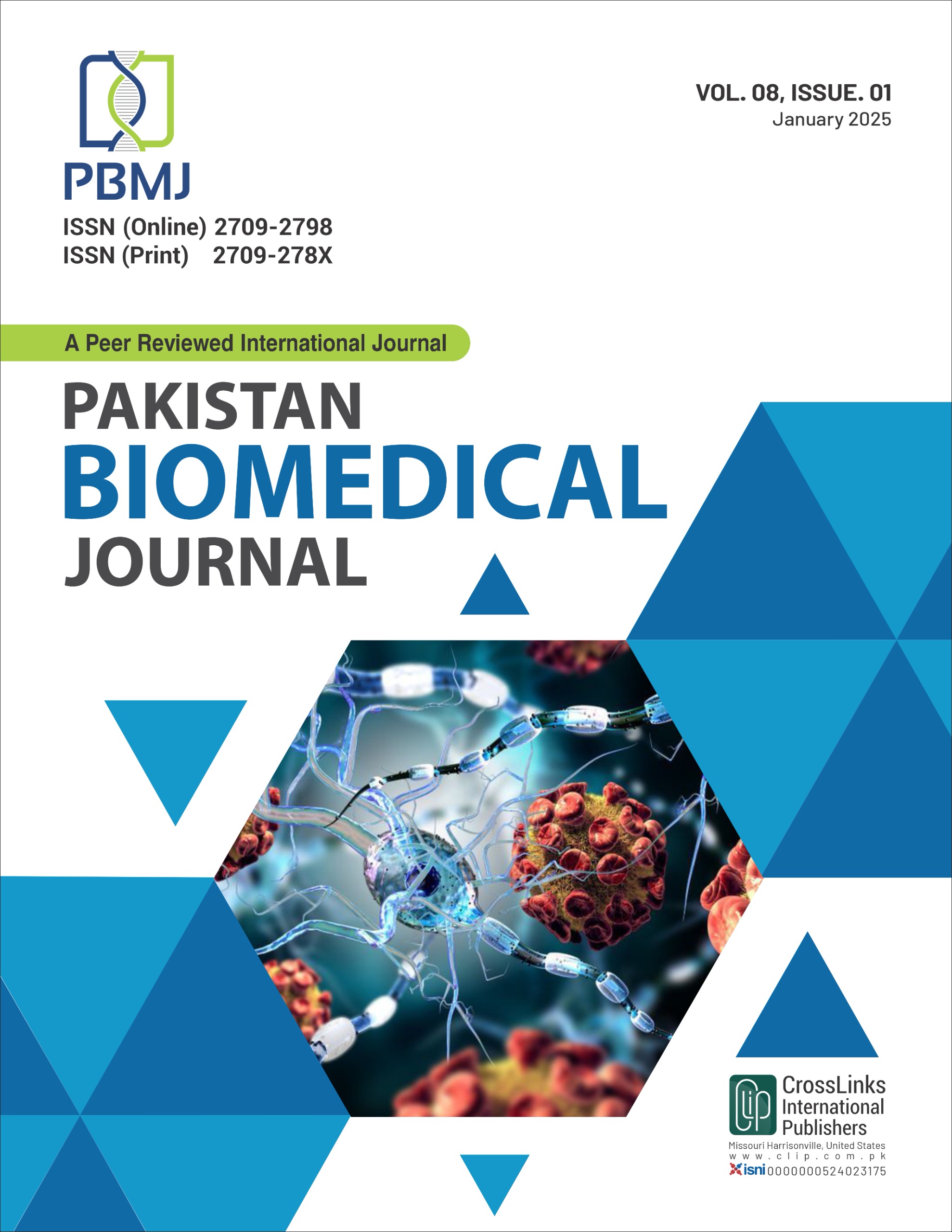Emerging Trends in Bioprinting for Cartilage Regeneration: Materials, Techniques and Challenges
Bioprinting for Cartilage Regeneration
DOI:
https://doi.org/10.54393/pbmj.v8i1.1186Keywords:
Cartilage Regeneration, Bioprinting, Biomaterial, Emerging TechnologiesAbstract
Cartilage repair is a major clinical problem because of the poor intrinsic healing capacity of cartilage coupled with the limitations of conventional therapies and synthetic substitutes. These challenges have been pursued by bioprinting, which is a technique that can generate scaffolds that mimic native cartilage. This review aims to discuss current and future development of bioprinting for cartilage tissue regeneration with a focus on the most common biomaterials such as alginate, gelatin, and collagen, along with the emerging materials such as smart hydrogels, nanomaterials, and bioactive molecules. The review also outlines other emerging bioprinting technologies like high resolution, 4D, hybrid, and microfluidic assisted bioprinting that are believed to improve the mechanical properties, biological integration and vascularization of the constructs produced through bioprinting. Some of the major problems which are still unresolved are those of scale up, biocompatibility and immune response that hinders the clinical application of bioprinted cartilage. The review further concludes that owing to some regulatory issues along with a lack of an ideal practice the challenges in bioprinting for cartilage regeneration still persists. Some of the future prospects that have been highlighted include the use of patient derived cells, artificial intelligence for process optimization and the development of smart and adaptive biomaterials. Mitigating these challenged and integrated these advanced technologies will enable the clinical translation of bioprinted cartilage to develop personalized, functional, and durable tissue constructs.
References
Galarraga JH, Kwon MY, Burdick JA. 3D bioprinting via an in situ crosslinking technique towards engineering cartilage tissue. Scientific Reports. 2019 Dec; 9(1): 19987. doi: 10.1038/s41598-019-56117-3. DOI: https://doi.org/10.1038/s41598-019-56117-3
Perera K, Ivone R, Natekin E, Wilga CA, Shen J, Menon JU. 3D bioprinted implants for cartilage repair in intervertebral discs and knee menisci. Frontiers in Bioengineering and Biotechnology. 2021 Oct; 9: 754113. doi: 10.3389/fbioe.2021.754113. DOI: https://doi.org/10.3389/fbioe.2021.754113
Liu H, Müller PE, Aszódi A, Klar RM. Osteochondrogenesis by TGF-β3, BMP-2 and noggin growth factor combinations in an ex vivo muscle tissue model: Temporal function changes affecting tissue morphogenesis. Frontiers in Bioengineering and Biotechnology. 2023 Mar; 11: 1140118. doi: 10.3389/fbioe.2023.1140118. DOI: https://doi.org/10.3389/fbioe.2023.1140118
Wei F, Liu S, Chen M, Tian G, Zha K, Yang Z et al. Host response to biomaterials for cartilage tissue engineering: key to remodeling. Frontiers in Bioengineering and Biotechnology. 2021 May; 9: 664592. doi: 10.3389/fbioe.2021.664592. DOI: https://doi.org/10.3389/fbioe.2021.664592
Łabowska MB, Cierluk K, Jankowska AM, Kulbacka J, Detyna J, Michalak I. A review on the adaption of alginate-gelatin hydrogels for 3D cultures and bioprinting. Materials. 2021 Feb; 14(4): 858. doi: 10.3390/ma14040858. DOI: https://doi.org/10.3390/ma14040858
Ren P, Wei D, Liang M, Xu L, Zhang T, Zhang Q. Alginate/gelatin-based hybrid hydrogels with function of injecting and encapsulating cells in situ. International Journal of Biological Macromolecules. 2022 Jul; 212: 67-84. doi: 10.1016/j.ijbiomac.2022.05.058. DOI: https://doi.org/10.1016/j.ijbiomac.2022.05.058
Serafin A, Culebras M, Collins MN. Synthesis and evaluation of alginate, gelatin, and hyaluronic acid hybrid hydrogels for tissue engineering applications. International Journal of Biological Macromolecules. 2023 Apr; 233: 123438. doi: 10.1016/j.ijbiomac.2023.123438. DOI: https://doi.org/10.1016/j.ijbiomac.2023.123438
Wierzbicka A, Bartniak M, Waśko J, Kolesińska B, Grabarczyk J, Bociaga D. The Impact of Gelatin and Fish Collagen on Alginate Hydrogel Properties: A Comparative Study. Gels. 2024 Jul; 10(8): 491. doi: 10.3390/gels10080491. DOI: https://doi.org/10.3390/gels10080491
Andreazza R, Morales A, Pieniz S, Labidi J. Gelatin-based hydrogels: potential biomaterials for remediation. Polymers. 2023 Feb; 15(4): 1026. doi: 10.3390/polym15041026. DOI: https://doi.org/10.3390/polym15041026
Jiao T, Lian Q, Lian W, Wang Y, Li D, Reis RL et al. Properties of collagen/sodium alginate hydrogels for bioprinting of skin models. Journal of Bionic Engineering. 2023 Jan; 20(1): 105-18. doi: 10.1007/s42235-022-00251-8. DOI: https://doi.org/10.1007/s42235-022-00251-8
Grover GN, Rao N, Christman KL. Myocardial matrix-polyethylene glycol hybrid hydrogels for tissue engineering. Nanotechnology. 2013 Dec; 25(1): 014011. doi: 10.1088/0957-4484/25/1/014011. DOI: https://doi.org/10.1088/0957-4484/25/1/014011
Rafat M, Li F, Fagerholm P, Lagali NS, Watsky MA, Munger R et al. PEG-stabilized carbodiimide crosslinked collagen-chitosan hydrogels for corneal tissue engineering. Biomaterials. 2008 Oct; 29(29): 3960-72. doi: 10.1016/j.biomaterials.2008.06.017. DOI: https://doi.org/10.1016/j.biomaterials.2008.06.017
El-Husseiny HM, Mady EA, Hamabe L, Abugomaa A, Shimada K, Yoshida T et al. Smart/stimuli-responsive hydrogels: Cutting-edge platforms for tissue engineering and other biomedical applications. Materials Today Bio. 2022 Jan; 13: 100186. doi: 10.1016/j.mtbio.2021.100186. DOI: https://doi.org/10.1016/j.mtbio.2021.100186
Bordbar-Khiabani A and Gasik M. Smart hydrogels for advanced drug delivery systems. International Journal of Molecular Sciences. 2022 Mar; 23(7): 3665. doi: 10.3390/ijms23073665. DOI: https://doi.org/10.3390/ijms23073665
Di Marzio N, Eglin D, Serra T, Moroni L. Bio-fabrication: convergence of 3D bioprinting and nano-biomaterials in tissue engineering and regenerative medicine. Frontiers in Bioengineering and Biotechnology. 2020 Apr; 8: 326. doi: 10.3389/fbioe.2020.00326. DOI: https://doi.org/10.3389/fbioe.2020.00326
Theus AS, Ning L, Jin L, Roeder RK, Zhang J, Serpooshan V. Nanomaterials for bioprinting: functionalization of tissue-specific bioinks. Essays in Biochemistry. 2021 Aug; 65(3): 429-39. doi: 10.1042/EBC20200095. DOI: https://doi.org/10.1042/EBC20200095
Thielen NG, van der Kraan PM, van Caam AP. TGFβ/BMP signaling pathway in cartilage homeostasis. Cells. 2019 Aug; 8(9): 969. doi: 10.3390/cells8090969. DOI: https://doi.org/10.3390/cells8090969
Wu M, Wu S, Chen W, Li YP. The roles and regulatory mechanisms of TGF-β and BMP signaling in bone and cartilage development, homeostasis and disease. Cell Research. 2024 Feb; 34(2): 101-23. doi: 10.1038/s41422-023-00918-9. DOI: https://doi.org/10.1038/s41422-023-00918-9
Keller B, Yang T, Chen Y, Munivez E, Bertin T, Zabel B et al. Interaction of TGFβ and BMP signaling pathways during chondrogenesis. PLOS One. 2011 Jan; 6(1): e16421. doi: 10.1371/journal.pone.0016421. DOI: https://doi.org/10.1371/journal.pone.0016421
Crawford L, Wyatt M, Bryers J, Ratner B. Biocompatibility evolves: phenomenology to toxicology to regeneration. Advanced Healthcare Materials. 2021 Jun; 10(11): 2002153. doi: 10.1002/adhm.202002153. DOI: https://doi.org/10.1002/adhm.202002153
Vijayavenkataraman S. 3D bioprinting: challenges in commercialization and clinical translation. Journal of 3D Printing in Medicine. 2023 May; 7(2): 3DP8. doi: 10.2217/3dp-2022-0026. DOI: https://doi.org/10.2217/3dp-2022-0026
Jing X, Fu H, Yu B, Sun M, Wang L. Two-photon polymerization for 3D biomedical scaffolds: Overview and updates. Frontiers in Bioengineering and Biotechnology. 2022 Aug; 10: 994355. doi: 10.3389/fbioe.2022.994355. DOI: https://doi.org/10.3389/fbioe.2022.994355
Valente F, Hepburn MS, Chen J, Aldana AA, Allardyce BJ, Shafei S et al. Bioprinting silk fibroin using two-photon lithography enables control over the physico-chemical material properties and cellular response. Bioprinting. 2022 Mar; 25: e00183. doi: 10.1016/j.bprint.2021.e00183. DOI: https://doi.org/10.1016/j.bprint.2021.e00183
Yazdanpanah Z, Johnston JD, Cooper DM, Chen X. 3D bioprinted scaffolds for bone tissue engineering: State-of-the-art and emerging technologies. Frontiers in Bioengineering and Biotechnology. 2022 Apr; 10: 824156. doi: 10.3389/fbioe.2022.824156. DOI: https://doi.org/10.3389/fbioe.2022.824156
Serex L, Sharma K, Rizov V, Bertsch A, McKinney JD, Renaud P. Microfluidic-assisted bioprinting of tissues and organoids at high cell concentrations. Biofabrication. 2021 Mar; 13(2): 025006. doi: 10.1088/1758-5090/abca80. DOI: https://doi.org/10.1088/1758-5090/abca80
Lee B, Kim S, Ko J, Lee SR, Kim Y, Park S et al. 3D micromesh-based hybrid bioprinting: multidimensional liquid patterning for 3D microtissue engineering. NPG Asia Materials. 2022 Dec; 14(1): 6. doi: 10.1038/s41427-022-00355-x. DOI: https://doi.org/10.1038/s41427-022-00355-x
Chen A, Su J, Li Y, Zhang H, Shi Y, Yan C et al. 3D/4D printed bio-piezoelectric smart scaffolds for next-generation bone tissue engineering. International Journal of Extreme Manufacturing. 2023 Jun; 5(3): 032007. doi: 10.1088/2631-7990/acd88f. DOI: https://doi.org/10.1088/2631-7990/acd88f
Davoodi E, Sarikhani E, Montazerian H, Ahadian S, Costantini M, Swieszkowski W et al. Extrusion and microfluidic‐based bioprinting to fabricate biomimetic tissues and organs. Advanced Materials Technologies. 2020 Aug; 5(8): 1901044. doi: 10.1002/admt.201901044. DOI: https://doi.org/10.1002/admt.201901044
Tan EY, Suntornnond R, Yeong WY. High-resolution novel indirect bioprinting of low-viscosity cell-laden hydrogels via model-support bioink interaction. 3D Printing and Additive Manufacturing. 2021 Feb; 8(1): 69-78. doi: 10.1089/3dp.2020.0153. DOI: https://doi.org/10.1089/3dp.2020.0153
Guillotin B, Souquet A, Catros S, Duocastella M, Pippenger B, Bellance S et al. Laser assisted bioprinting of engineered tissue with high cell density and microscale organization. Biomaterials. 2010 Oct; 31(28): 7250-6. doi: 10.1016/j.biomaterials.2010.05.055. DOI: https://doi.org/10.1016/j.biomaterials.2010.05.055
Keriquel V, Oliveira H, Rémy M, Ziane S, Delmond S, Rousseau B et al. In situ printing of mesenchymal stromal cells, by laser-assisted bioprinting, for in vivo bone regeneration applications. Scientific Reports. 2017 May; 7(1): 1778. doi: 10.1038/s41598-017-01914-x. DOI: https://doi.org/10.1038/s41598-017-01914-x
Qu G, Huang J, Gu G, Li Z, Wu X, Ren J. Smart implants: 4D-printed shape-morphing scaffolds for medical implantation. International Journal of Bioprinting. 2023 May; 9(5): 764. doi: 10.18063/ijb.764. DOI: https://doi.org/10.18063/ijb.764
Gopinathan J and Noh I. Recent trends in bioinks for 3D printing. Biomaterials Research. 2018 Apr; 22(1): 11. doi: 10.1186/s40824-018-0122-1. DOI: https://doi.org/10.1186/s40824-018-0122-1
Mainardi VL, Arrigoni C, Bianchi E, Talò G, Delcogliano M, Candrian C et al. Improving cell seeding efficiency through modification of fiber geometry in 3D printed scaffolds. Biofabrication. 2021 Apr; 13(3): 035025. doi: 10.1088/1758-5090/abe5b4. DOI: https://doi.org/10.1088/1758-5090/abe5b4
Liang Q, Ma Y, Yao X, Wei W. Advanced 3D-printing bioinks for articular cartilage repair. International Journal of Bioprinting. 2022 Apr; 8(3): 511. doi: 10.18063/ijb.v8i3.511. DOI: https://doi.org/10.18063/ijb.v8i3.511
Zhou J, Li Q, Tian Z, Yao Q, Zhang M. Recent advances in 3D bioprinted cartilage-mimicking constructs for applications in tissue engineering. Materials Today Bio. 2023 Dec; 23. doi: 10.1016/j.mtbio.2023.100870. DOI: https://doi.org/10.1016/j.mtbio.2023.100870
Gonçalves RC, Banfi A, Oliveira MB, Mano JF. Strategies for re-vascularization and promotion of angiogenesis in trauma and disease. Biomaterials. 2021 Feb; 269: 120628. doi: 10.1016/j.biomaterials.2020.120628. DOI: https://doi.org/10.1016/j.biomaterials.2020.120628
Shineh G, Patel K, Mobaraki M, Tayebi L. Functional approaches in promoting vascularization and angiogenesis in bone critical-sized defects via delivery of cells, growth factors, drugs, and particles. Journal of Functional Biomaterials. 2023 Feb; 14(2): 99. doi: 10.3390/jfb14020099. DOI: https://doi.org/10.3390/jfb14020099
Tripathi AS, Zaki ME, Al-Hussain SA, Dubey BK, Singh P, Rind L et al. Material matters: exploring the interplay between natural biomaterials and host immune system. Frontiers in Immunology. 2023 Oct; 14: 1269960. doi: 10.3389/fimmu.2023.1269960. DOI: https://doi.org/10.3389/fimmu.2023.1269960
Salthouse D, Novakovic K, Hilkens CM, Ferreira AM. Interplay between biomaterials and the immune system: Challenges and opportunities in regenerative medicine. Acta Biomaterialia. 2023 Jan; 155: 1-8. doi: 10.1016/j.actbio.2022.11.003. DOI: https://doi.org/10.1016/j.actbio.2022.11.003
Ruiz-Cantu L, Gleadall A, Faris C, Segal J, Shakesheff K, Yang J. Multi-material 3D bioprinting of porous constructs for cartilage regeneration. Materials Science and Engineering: C. 2020 Apr; 109: 110578. doi: 10.1016/j.msec.2019.110578. DOI: https://doi.org/10.1016/j.msec.2019.110578
Shopova D, Yaneva A, Bakova D, Mihaylova A, Kasnakova P, Hristozova M et al. (Bio) printing in personalized medicine-opportunities and potential benefits. Bioengineering. 2023 Feb; 10(3): 287. doi: 10.3390/bioengineering10030287. DOI: https://doi.org/10.3390/bioengineering10030287
Downloads
Published
How to Cite
Issue
Section
License
Copyright (c) 2025 Pakistan BioMedical Journal

This work is licensed under a Creative Commons Attribution 4.0 International License.
This is an open-access journal and all the published articles / items are distributed under the terms of the Creative Commons Attribution License, which permits unrestricted use, distribution, and reproduction in any medium, provided the original author and source are credited. For comments editor@pakistanbmj.com











